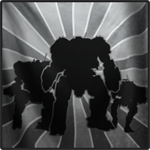I will try to explain how convergence works, and how we can compensate for (poor) convergence based on terrain-to-LOS intersection as it exists right now. For simplicity, I will assume that both the target and your mech are sitting on perfectly level terrain, with the only raised feature being the background wall that is the line-of-sight intersection target. Facing the sky (when the distance meter on your reticle says infinity) means that your weapons, regardless of position, will fire directly ahead with zero convergence. Zip. Nada.

This diagram illustrates the basic variables in convergence calculations. Distances to the left and right weapon clusters (here assumed to be torso slots) are counted as d_rt and d_lt respectively. The distance to the target (that you are trying to hit) and the target (that the game assumes you are trying to hit) are represented by d_tgt and d_los respectively. Notice how these two distances are different. Theta is the angle that the RT or LT weapon needs to turn to face the LOS target, which is always the intersection of a line from your cockpit passing through either the torso targeting reticle (the x-shaped one in game) or the arm targeting reticle (the o-shaped one in game).
Suppose your weapons are in the CT, and you are firing. This is equivalent to setting d_rt and d_lt to a value approaching zero. Given the nature of trigonometry on small numbers, for these weapons to converge on the LOS target, theta must be equal to or approximately equal to 90 degrees, as the target is always directly in front of your cockpit (give or take a very small amount).
Now, compare this to a weapon that is on the RA of a mech which is about 10m to the right of your cockpit. If the LOS target is 200m away, this is an angle of (arctan (200 / 10)), or 63.43 degrees. At this distance, your projectiles will converge; but before that, your projectiles will actually arrive at some distance apart. This distance can be calculated as:
( sin(theta) * d_rt + sin(theta) * d_lt), where
theta = { arctan (d_los / d_rt) for RT weapons, arctan(d_los / d_lt) for LT weapons }
The wider your mech, the worse the convergence error becomes. The closer the actual target versus the LOS target, the worse the convergence error becomes. Note that mechs with asymmetric cockpit positioning on the body (e.g. Summoner, Thunderbolt) will have different theta values for the right and left weapon sets.
Let us assume that you, in a wide-bodied mech with its weapons on its arms, are firing at a target moving directly perpendicular to your mech's LOS from the right.. You are leading the mech, assuming that the LOS target is the same distance as your actual target; and had it been true, you would have hit. You decide to fire an alpha, thinking that all of the damage will hit the mech. This is what will actually happen:
[img=http://s4.postimg.org/e0nresy3d/convergence_wrong_t0.jpg][/img]


The alpha appears to be travelling to intercept the target correctly. However, the alpha fails to converge on the target. The side closer to the actual target connects, or partially connects, but the other side misses completely and hits the terrain in front of the actual target.
This, in real situations, may be either a complete miss, or a partial hit (if SRMs or Clan UACs are considered, this is most likely to happen). Not a good result. Let us try compensating for it:



Much better! You aim ahead of the target, and fire the left side half-alpha first. The shots connect, and you now compensate for the other side. You fire the right side half-alpha, and that connects too. No wasted ammo, no wasted heat, no wasted damage.
Edited by ArcturusWolf, 23 December 2015 - 04:13 AM.





















